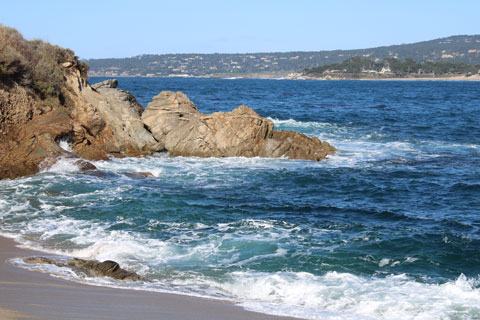Monastery Beach
Monastery Beach, named for the Carmelite Monastery across the highway, is part of Carmel River State Beach. The beach is sometimes called San Jose Creek Beach. The one-third-mile-long stretch of sand is most popular with divers. There is limited but convenient parking along the shoulder of Highway 1 right at the beach. A restroom is located at the southern end of the beach. In 2019 a lifeguard tower was added to the beach in order to make this dangerous beach a little safer. The lifeguard tower is staffed through the summer season.

Monastery Beach
Diving at Monastery Beach
Experienced scuba divers find Monastery Beach a great place to use as a base for underwater explorations. Entering from the north end of the beach, divers soon find themselves at the edge of the Monterey Canyon, a 95-mile-long underwater canyon that achieves depths of 2 miles. The canyon supports a broad diversity of marine life.
Divers at Monastery Beach find fabulous rock formations, towering stands of kelp, and a myriad of sea life in the canyon. Vibrant colors, good visibility, huge schools of fish, and fascinating invertebrates bring divers back time and again.
From the south end of Monastery Beach, divers often launch kayaks or other small inflatables in order to reach diving spots farther from shore. To the south is the rugged shorelines of Granite Point and Point Lobos. Divers report seeing numerous harbor seals, sea lions, kelp rockfish, blue rockfish, calico bass, perch, lingcod, cabezon, anemones, and sunflower stars.
Kayaking from Monastery Beach
Kayakers like to launch their boats from the south end of Monastery Beach when the wave conditions are safe. Because of the hazards mentioned above, this is a site for experienced sea kayakers only. Safer launch sites are located in nearby Point Lobos State Park.
Kayakers are wary of the currents around ocean rocks and stay well clear of them. Paddling west, parallel to the shore, kayakers often head toward Point Lobos and take time to explore the numerous coves and inlets along the way. China Cove is a favorite destination.

